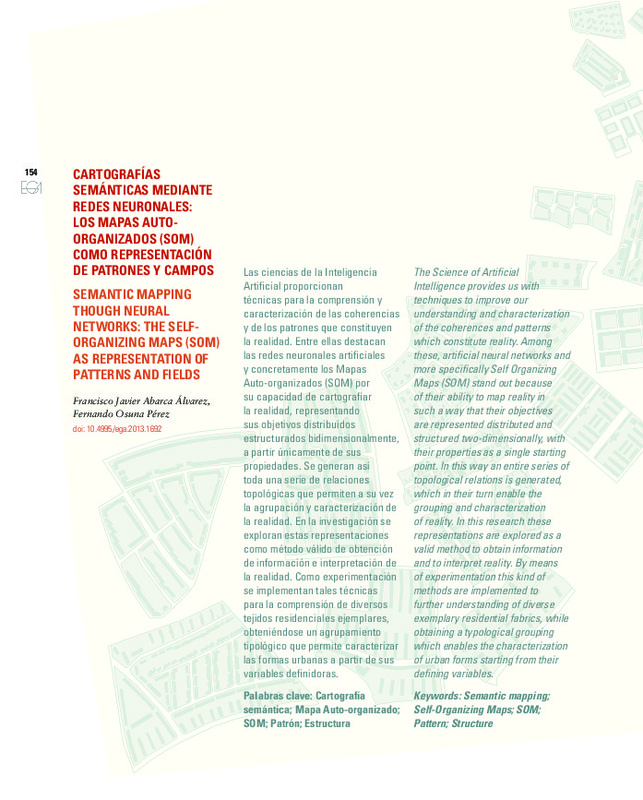JavaScript is disabled for your browser. Some features of this site may not work without it.
Buscar en RiuNet
Listar
Mi cuenta
Estadísticas
Ayuda RiuNet
Admin. UPV
Cartografías semánticas mediante redes neuronales: los mapas auto-organizados (SOM) como representación de patrones y campos
Mostrar el registro sencillo del ítem
Ficheros en el ítem
| dc.contributor.author | Abarca-Alvarez, Francisco Javier
|
es_ES |
| dc.contributor.author | Osuna Pérez, Fernando
|
es_ES |
| dc.date.accessioned | 2016-12-23T09:40:12Z | |
| dc.date.available | 2016-12-23T09:40:12Z | |
| dc.date.issued | 2013-11-06 | |
| dc.identifier.issn | 1133-6137 | |
| dc.identifier.uri | http://hdl.handle.net/10251/75710 | |
| dc.description.abstract | [EN] The Science of Artificial Intelligence provides us with techniques to improve our understanding and characterization of the coherences and patterns which constitute reality. Among these, artificial neural networks and more specifically Self Organizing Maps (SOM) stand out because of their ability to map reality in such a way that their objectives are represented distributed and structured two-dimensionally, with their properties as a single starting point. In this way an entire series of topological relations is generated, which in their turn enable the grouping and characterization of reality. In this research these representations are explored as a valid method to obtain information and to interpret reality. By means of experimentation this kind of methods are implemented to further understanding of diverse exemplary residential fabrics, while obtaining a typological grouping which enables the characterization of urban forms starting from their defining variables | es_ES |
| dc.description.abstract | [ES] Las ciencias de la Inteligencia Artificial proporcionan técnicas para la comprensión y caracterización de las coherencias y de los patrones que constituyen la realidad. Entre ellas destacan las redes neuronales artificiales y concretamente los Mapas Auto-organizados (SOM) por su capacidad de cartografiar la realidad, representando sus objetivos distribuidos estructurados bidimensionalmente, a partir únicamente de sus propiedades. Se generan así toda una serie de relaciones topológicas que permiten a su vez la agrupación y caracterización de la realidad. En la investigación se exploran estas representaciones como método válido de obtención de información e interpretación de la realidad. Como experimentación se implementan tales técnicas para la comprensión de diversos tejidos residenciales ejemplares, obteniéndose un agrupamiento tipológico que permite caracterizar las formas urbanas a partir de sus variables definidoras. | es_ES |
| dc.language | Español | es_ES |
| dc.language | Inglés | es_ES |
| dc.publisher | Universitat Politècnica de València | |
| dc.relation.ispartof | EGA. Revista de Expresión Gráfica Arquitectónica | |
| dc.rights | Reserva de todos los derechos | es_ES |
| dc.subject | Cartografía semántica | es_ES |
| dc.subject | Mapa Auto-organizado | es_ES |
| dc.subject | SOM | es_ES |
| dc.subject | Patrón | |
| dc.subject | Estructura | |
| dc.title | Cartografías semánticas mediante redes neuronales: los mapas auto-organizados (SOM) como representación de patrones y campos | es_ES |
| dc.title.alternative | SEMANTIC MAPPING THOUGH NEURAL NETWORKS: THE SELF-ORGANIZING MAPS (SOM) AS REPRESENTATION OF PATTERNS AND FIELDS | es_ES |
| dc.type | Artículo | es_ES |
| dc.date.updated | 2016-12-23T08:41:26Z | |
| dc.identifier.doi | 10.4995/ega.2013.1692 | |
| dc.rights.accessRights | Abierto | es_ES |
| dc.description.bibliographicCitation | Abarca-Alvarez, FJ.; Osuna Pérez, F. (2013). Cartografías semánticas mediante redes neuronales: los mapas auto-organizados (SOM) como representación de patrones y campos. EGA. Revista de Expresión Gráfica Arquitectónica. 18(22):154-163. https://doi.org/10.4995/ega.2013.1692 | es_ES |
| dc.description.accrualMethod | SWORD | es_ES |
| dc.relation.publisherversion | https://doi.org/10.4995/ega.2013.1692 | es_ES |
| dc.description.upvformatpinicio | 154 | es_ES |
| dc.description.upvformatpfin | 163 | es_ES |
| dc.type.version | info:eu-repo/semantics/publishedVersion | es_ES |
| dc.description.volume | 18 | |
| dc.description.issue | 22 | |
| dc.identifier.eissn | 2254-6103 |








